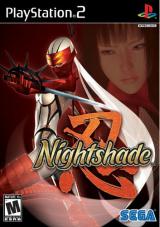Few recent games have sparked as much conflict between gamer and reviewer as Sega's PS2 Shinobi. Many reviewers, myself included, found it to be an interesting but flawed action game. But serious fans proclaimed it to be one of the best of the generation, an incredible title unfairly snubbed by the gaming media who didn't appreciate its hardcore, unforgiving subtleties. Regardless of who's right, the follow-up game Nightshade attempts to bridge the gap with gameplay that's a little more forgiving while retaining the Shinobi feel. The result isn't perfect, but for most of us it's probably a step in the right direction.
Nightshade is more a side story than a direct Shinobi sequel, and stars the lythe Hibana, sort of the Lucy to Hotsuma's Desi. (Or not.) Our lovely ninja chick has twelve tough stages of disgusting hellspawn and merciless robots to slog through before calling it a day, and actually, that's when the challenge really begins ... but let's not get ahead of ourselves here.
Shinobi Redux
Played Shinobi? If so, you'll have a very good idea of what to expect from Nightshade. There are only a few major tweaks, gameplay or otherwise, but together they help to make this a considerably more accessible game than Shinobi ever was. In my book, that's a good thing.
As before, the general goal of the gameplay is to string enemy kills together in quick and efficient fashion; this process is called tate (pronounced "tah-tay"). Take too long in putting the sequence together and the tate will end unfinished, resulting in lost points and damage potential (your later hits get stronger and stronger). A skillful use of tate can kill bosses in seconds. Thankfully for reviewing wusses like myself (not to mention normal people), Hibana sports a new jumpkick that can extend her airtime considerably. This makes tate a much easier proposition in many places, as you can double-jump, dash and then jump kick between each enemy, preventing you from falling into those horrible pits.
But fall you will, and many times, as Nightshade has just as many pitfalls as its predecessor -- probably more. As before, this counts as an instant game over, and there's little that's more frustrating than falling into a pit right near the end of a long, intricate section. The developers have listened to player feedback by implementing checkpoints in many levels, from which you can continue upon dying. However, you'll still have to play for five minutes at a stretch, oftentimes, without such security.
While this is a huge improvement over the notoriously unforgiving original, I still feel that the game is a little too harsh. There were times when I would be blowing through a stage, getting every tate, every secret coin, and then die right before the end due to a random mishap that threw me into the abyss. The prospect of repeating all that brilliance (only to risk the killer pit near the end, again) is not endearing, so sometimes I'd just run through the level, avoiding enemies, to get back to where I was. That's completely against the spirit of Nightshade's scoring and performance-focused gameplay, but don't tell that to me when I'm pissed at just losing ten minutes of solid performance to a damn pit. There is a middle ground to be found between "too easy" and "cheap and too hard," and the Nightshade team hasn't quite found it yet. They are getting closer, though.




 Average
Average



